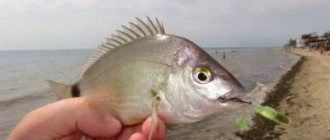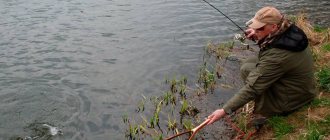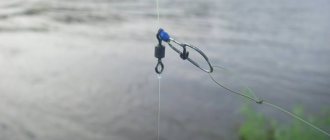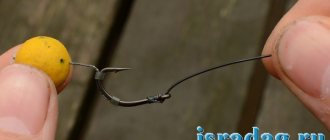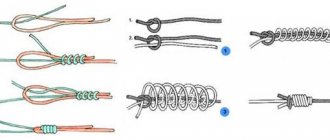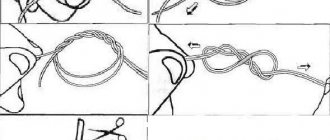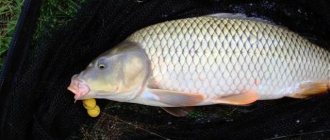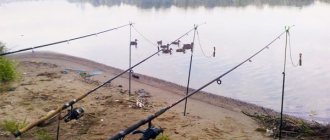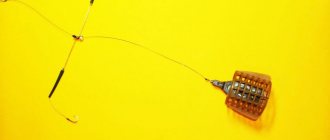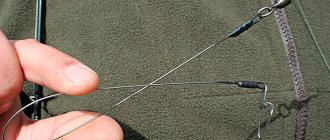Fishing with boilies has long been no longer exotic for our domestic fisherman, and especially for carp fishing enthusiasts. This innovative bait has deservedly entered the rank of popular and effective baits, applicable under any fishing conditions for many peaceful fish from the carp family. It is especially convenient to use boilies when fishing for carp. The bait reveals the widest range of possibilities for hunting this powerful fish, based on its size, aromatic and taste qualities, as well as color and buoyancy properties. In addition, equipment for catching carp with boilies is not particularly difficult to install and assemble and is available in design and material-intensive parameters to every fisherman.
These carp baits are available in a variety of ways in fishing store chains, and for experienced and creatively gifted carp anglers, making boilies at home has become a common and entertaining task. We will talk about the specifics of using this interesting bait throughout our article, revealing the secrets of the best conditions for using baits in conjunction with fishing equipment, and introduce the reader to the basic properties of the bait and methods for preparing it at home. We will also determine the nuances of installations and discuss technical fishing techniques that allow you to fish comfortably and successfully with boilies.
What is a boilie
The main component of the nasada is the base, created from dough mixed with corn, semolina or rye flour with the addition of the strongest concentrated flavors.
Important! It is the concentrate of odors that is the basis of the attractiveness of the bait, attracting fish to the fishing point by its distribution in the reservoir.

After mixing the mixture, it is formed into balls of various sizes, or rolled into a cylinder, cut into individual dimensional elements, obtaining the so-called pelets, and boiled in boiling water for a short period of time. After cooking, the products are dried and stored frozen or in sealed bags without access to oxygen.
As a result, the best boilies for carp fishing look like an attractive candy pellet of various colors, hard to the touch and smelling strongly of a specific attractant. This product is already completely ready for use and does not require additional preparation from the fisherman. It is stored for quite a long time, before installation it undergoes only modifications for fastening on the equipment elements selected for the fishing session.
Types of nozzles
Floating boilies, sinking boilies, suspenders and dusting options are the main types of baits of this type. Application according to the above classification is based on the structure of the bottom of the reservoir in which fishing is carried out. The buoyancy properties of the material are achieved by different methods of preparing the product.
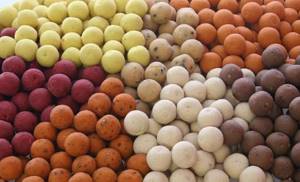
Floating boilies cook less sinking bait, thereby allowing oxygen to remain inside the ball. Instantly soluble elements such as milk powder, breadcrumb dust and similar ingredients are added to the dusting nozzles. Based on the size and shape of the bait, they are divided into fishing and bait directions. For the most part, balls with a diameter greater than a centimeter are catchable. Groundbait, smaller pellet-shaped and cylindrical pellet-shaped options.
Fishing boilies are distinguished by a high degree of resistance to soaking and density, which allows, without excessive internal deformations leading to cracking of the product, through punctures and drilling of the material for mounting bait on a hook or hairline.
Features of catching carp fish with boilies
Before starting fishing with boilies, the angler will need to carefully study the structure of the bottom of the reservoir. After all, the correct type of use of bait depends on this characteristic.
Important! On hard sandy or clay bottoms, sinking boilies are used, which lie on the bottom.
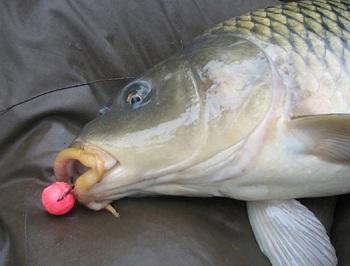
Dusting baits are used as bait and bait, which attract fish from afar by creating cloudy pop-up spots, additionally arousing interest in the fishing spot. A combination of sinking and dusting baits on currents also works effectively, spreading a trail of edible and odorous particles over long distances. In reservoirs with an overgrown bottom or deep silt deposits, combinations of suspenders for fishing and floating bait options for complementary feeding are used. Floating boilies, located in the upper layers of the water horizon, attract fish to the fishing point by spreading the smell and creating a glare shadow. It is more natural and safer for fish to collect suspenders in the water column, closer to the bottom. Incorrect selection of bait based on its buoyancy properties leads to the burying of drowning species in silt, which makes them completely inaccessible to fish and prevents them from biting.
Dimensions
Large carp prefer larger baits. In connection with this observation, bait manufacturers have identified the main size ranges of baits, which are successfully used in carp fishing for proper feeding and catching trophy fish. All options, starting from a couple of millimeter diameter pelets and ending with balls up to half a centimeter in size, are classified as a groundbait type of bait. Starting from a half-centimeter diameter and ending with super-heavy balls of 3-3.5 centimeters, the nozzle is considered a purely fishing material. Based on these product size parameters, the angler can easily determine the material for feeding and the material for direct attachment in the installation of equipment. This selection principle allows you to cut off small fish from baits and expect only trophy and truly large specimens in your catches.
Color
Catching carp with boilies also has its own nuances regarding the choice of bait, based on its coloring.

Important! The main factor in color selection is fishing depth.
The manufacturer offers the product itself in a wide range of colors, ranging from pure white options to jet black anthracite shades. In carp fishing, it is customary to use light green, acid green and yellow, white in various shades of color at depths of over three meters.
Important! Bait and fishing material are always graded according to the brightness of use, highlighting the fishing element with a more saturated color.
This technique allows the fish to quickly find and take the bait with the hook, thereby making the bite quicker in time and ultimately effective. At shallower depths, carp anglers supply baits painted in red, orange, crimson and intense pink, providing bait with darker tones, including blue, light blue and black bait elements.
Types of boilies
On the counter of fishing stores there is a wide range of baits that differ in size, color and method of preparation.
Drowning
The density of this type of bait is so high that the bait easily sinks to the bottom immediately after casting the tackle. The sinking bait is also made from cereal crops, but the production technology is aimed primarily at giving these products more weight. The balls have significant strength, so they can be used as the main bait even when fishing in sections of rivers with strong currents.
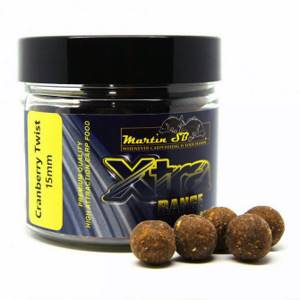
Sinking baits are used primarily for catching bottom fish. The load quickly sinks even into very deep holes, where large specimens of carp fish can be found in the rubble of snags.
Floating
Floating boilies, on the contrary, remain buoyant due to the fact that their density is much lower than that of water. To provide greater buoyancy, small foam balls can be used in the design of fishing gear. This type of fishing attachment is used when it is necessary to catch a specimen feeding in the upper layers of water.
Do-it-yourself boilies for carp
Boilies for carp can also be made at home using a set of standard and publicly available ingredients that are affordable to every fisherman. Initially, you will need to stock up on semolina or corn flour, have a couple of fresh chicken eggs, purchase a concentrated attractant, of which there is plenty in fishing stores today to suit every taste, and choose a food coloring based on the desired color of the final product. The dough made from flour with the addition of eggs is stirred in water until it reaches a consistency that allows it to not spread out after molding the dough into shapes, maintaining the structure of a ball or cylinder.
Important! Table salt is included in the finished mass to impart preservation properties.
After the next mixing, an attractant is added. After this operation, the dough is made into the required sizes and dried at room temperature for a couple of hours. After drying, the workpieces are immersed in boiling water. The exposure time in boiling water depends on the requirements for subsequent buoyancy properties. The sinking product is cooked longer than the suspended or floating version. As a rule, dipping for one and a half to two minutes makes the material sink. Shorter periods of time allow the bait to stay in the water column.
After boiling, the balls are dried in the open air and the already dried ones are painted, subsequently frozen or packed in an airtight bag. Recipes for boilies for catching carp differ to a large extent only in the use of different kinds of aromas, cooking time and color of the finished product.
Elements of carp equipment and boilies
Choosing a kit for installing carp boilies is not easy for a novice carp angler. The following is a list of what is needed first. The classic minimum will allow you to save money and avoid purchasing unnecessary things, which is important considering the prices of equipment and gear. Fishing for carp with boilies has recently become more and more popular, turning carp anglers into float and spinning anglers, as well as those who were not previously interested in fishing at all.
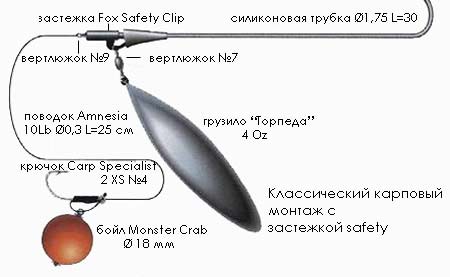
Shock leader
Installed at the end of the main line. Length - at least 10 meters. Has increased strength. Necessary for confident power casting of a heavy sinker over long distances, without the risk of breaking the main line. Allows great effort on gear at the final stage of fishing. Resists rocky bottom or shell rock. There are varieties in the form of braided or monofilament.
Sinkers
The weights, according to the method of fastening, are divided into weights with a through hole, which are attached directly to the shock leader, and with a built-in swivel for safe installation - secured using a special clip.
They come in various shapes - for example, “flat with spikes” - used in the current, in the shape of an olive - better suited for muddy reservoirs. Ensures self-hatching of the fish, acting on the principle of an anchor, when the carp tries to move with the bait in its mouth.
It is also necessary to have a back sinker (Back Lead), which serves to press the fishing line to the bottom, directly next to the rod. In case of catching fish, it prevents gear tangling.
Safety clip
Mounting devices that serve to attach the sinker to the shock leader. Provides self-release of the sinker in the event of a break in the gear, thereby freeing the fish from the weight of the sinker and saving its life.
Lead material
To make a leash, special leash cords for carp are used. Durability, abrasion resistance, softness. Hard leashes, for example made of fluorocarbon, can also be used.
Hooks
For the most part, hooks with a short shank and an inwardly curved tip and eye are used. Such hooks provide a greater probability of hooking when the sting is turned downwards in the carp's mouth, as well as reliability of hooking. Also used for certain types of installations and for the angler’s choice, other forms of hooks are curved hooks with a long shank, hooks with a short shank and an outwardly inclined eye, with a straight hook, etc.
Line stoppers
Rubber stops are put on the fishing line and serve as a buffer between the heavy sinker and the knots on the fishing line, protecting the latter from destruction.
Stoppers for boilies
Pieces of plastic tube, attached to the end of the hair with a nozzle, fix the boilies.
Anti-twist
A tube that prevents the leash from getting tangled is used in the designs of most rigs.
Swivels
Used to connect a leash with a shock leader.
Soft lead
Used to rub the leash in order to sink it. In the case of using floating boilies, part of the leash is rubbed with lead and thus the height of submergence of the nozzle is limited.
Heat shrink tube
Used in certain types of equipment. The leader is put on the shock or to set the required angle of interface between the hook and the leash, thus increasing the likelihood of hooking a fish.
Rubber cord
A knot is tied on the fishing line to fix the casting distance at a certain distance.
Special silicone tube
In certain types of installations, it is put on the hook and hair, allowing you to change the length of the hair and the point of its attachment to the hook.
PVA elements
Water-soluble materials in the form of tapes, bags, etc. Designed to send a small part of the bait along with the bait to the fishing point. They allow you to feed the area very precisely. They are attached to a rig or hook and filled with boilies or other bait.
Soluble foam - floats to the surface exactly above the point where the equipment falls in still water. Makes it possible to immediately feed the area by throwing bait using other means. Also, various designs are put on the hook, preventing it from catching when casting over the grass, etc. as well as hook tangling when using very soft leashes.
Glue
Usually the knots on carp gear are glued.
Spezigly
Used for attaching boilies to hair or PVA thread.
fishing line
You should not skimp on purchasing fishing line. A break in the gear in a situation where it should not have happened, as well as the impossibility of long-distance and accurate casting, will lead to damage to the nerve cells and will force you to re-purchase a product of the required quality.
First, it is better to use soft fishing lines like Fox Soft Steel (it is better when fishing and the casting distance increases). Subsequently, you can switch to hard options, but only of high quality, from well-known global manufacturers - Shimano, Daiwa, etc.
Boilies and their composition
Many carp anglers use homemade boilies, killing two birds with one stone. Firstly, we develop our own secret recipes for super catchy baits, and secondly, we save money, because the consumption of boilies during fishing will be considered packages, each of which (if we are talking about global brands) is not cheap.
Several simple recipes for making boilies at home. Components can be purchased without special orders.
Semolina – 1 part, milk powder – 1 part, corn flour – 1 part, soy flour – 0.7 parts, fish meal – 0.7 parts.
This is all mixed thoroughly and for a long time until a homogeneous composition is obtained.
During the mixing process, flavoring is added to the mixture at the rate of 4 teaspoons per 1 kg of mixture - for example, cocoa, vanilla, coriander are good.
Then the mixture is mixed with chicken eggs, at the rate of 10 eggs per 1 kg of mixture.
You can also add food coloring to the egg before mixing (one teaspoon per 1 kg of mixture), thus obtaining, for example, an ultra-orange color.
You can also add your own flavorings to the beaten egg - for example, 3 tablespoons of sunflower oil for 10 eggs.
Making boilies
After kneading, the dough is obtained, balls of the required size are molded from it (usually 14 - 18 mm in diameter). Note that molding many balls is a very lengthy and labor-intensive process; at least some kind of flavoring is desirable.
There are special tables for rolling out boilies on sale. This accessory will help you make at least boilies of the same size.
The finished balls are dipped into already boiling water. As soon as the balls begin to float in boiling water, they are immediately taken out and placed on a flat surface in one layer for long-term drying.
The longer boilies are dried, the harder they become. But the drying time is at least 2 weeks.
Another boilie recipe
Using a similar technology, boilies of a slightly different composition are prepared:
Wheat flour - 1 part, rice flour - 1 part, corn flour - 1 part, milk powder - 0.8 parts, bird feed (ground into dust) - 0.2 parts.
Or this composition of boilies for carp fishing: Semolina – 1 part, corn flour – 0.5 parts, soy flour – 0.5 parts, milk powder – 0.5 parts, powdered sugar – 0.12 parts.
Flavors and other components of boilies are a limitless experiment. You can mix “opposite” smells and find a strong version. For example, apply garlic juice and fruit essence at the same time. Increasing the animal component – fish or bone meal, preferable for fishing in cold water.
During the preparation process, it is advisable to first divide the entire mixture into several portions, and add its own flavor and coloring to each. You also need to cook them separately in your own water. Thus, several varieties of product can be prepared in one cooking. Then you should make a detailed note for memory, by type - “color” - “composition” - “expected effect”.
A typical mistake is an overdose of fragrances; you need to be careful with this and first act on the principle of the minimum. But only those who walk can master the road. Therefore, it’s worth experimenting, maybe it will work out...
Use of flavors and dips
It is especially worth focusing on the aromatic qualities of the bait, because aroma is the essence of the success of the bait. Carp have a sweet tooth by nature and love to feast on foods high in sugar and with a strong sweet smell. This is especially noticeable during the warm period of the fishing season from July to September. Honey, vanilla, the smell of tutti-frutti, various berry aromas such as raspberry, melon, banana and strawberry always tempt carp to bite . Catching carp in the fall with boilies, as in the spring in cool water, is more successful with the smell of natural protein food. Attractants with fish oil and bacon already dominate here. In some ponds, fishing is successful using the smells of coffee, cocoa and garlic.
Important! As a rule, a stock of baits with different aromatic tastes gives the chance for more successful fishing.
Equipment for catching carp with boilies
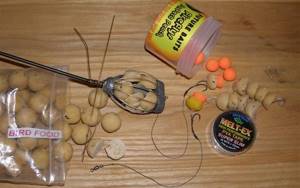
There is no special equipment for boilies; this is a fairly universal bait, which is successfully used in float, feeder and bottom fishing. The fisherman selects equipment based on the planned size and weight of the catch. In carp fishing, and in particular feeder fishing, special carp rods with reinforced rings and powerful reels equipped with a baitrunner are used. The main cords are braided lines with low stretch coefficients.
The float fishing rod is equipped with a monofilament line with diameters starting from 0.2 mm. Use stick-shaped floats no heavier than 2–5 grams with a garland of pellet weights and a leash with a hook. Also, baits of this type work effectively on classic bottom gear with elastic on leashes made of thin braided cords. Fishing with mini-boilies is also successfully carried out with plug rods equipped with a feeder and fine sensitive equipment.
Equipment
Most often, carp are caught using a hair rig. Such equipment is very easy to make and fishermen have not yet been able to come up with a more effective installation, so the advantages are obvious.
To make gear for carp fishing using boilies, you will need to stock up on some materials:
- driving material;
- carp hook;
- scissors;
- glue;
- silicone tube;

Installing the equipment is quite simple, you just need to follow a certain sequence of actions and have at least a small understanding of how to tie basic fishing knots:
- First you need to make a loop on the leash and tie it with a triple knot.
- Then you need to thread a piece of silicone tube onto the leash.
- Now you need to thread the second end of the leash into the eye of the hook.
- Then you need to make 6-8 turns around the forend.
- In the direction of the sting, through the ring of the hook, you need to pull the second end of the leash.
- Now you should glue the leash to the shank of the hook.
- The tackle can be used immediately after the glue has dried.
Hook mounting
The classic presentation of this type of bait has become hair rigging. This successful combination of equipment technology allowed us to fully reveal the concept of using bait. The hair allows not only to secure the bait efficiently, but also does not give the fish any doubt about the naturalness of the feed. After all, when trying a tasty treat, the carp does not feel the hook and is detected only when the bait is completely absorbed and swallows the food.
Read more about the different ways to attach a boilie to a hook.
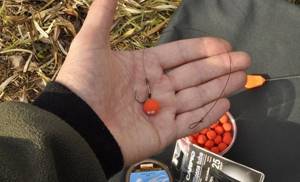
Important! To install the balls, special devices are used, needles with a hook and miniature drills, which make mounting through holes in them for threading the hair.
A silicone stopper, which reliably closes the installation, prevents the nozzle from inadvertently falling off during casting and being pulled off by the fish.
Recipes
For summer fishing, bait ingredients containing carbohydrates with the fragrant smell of spices or fruits are used.
First option:
- 0.5 cups of any seeds.
- 1 cup soy flour.
- 1.5 cups of birdseed.
- 1.5 cups of semolina.
- As many eggs as the dough will eat.
Second option:
- 2st. spoons of anise or cinnamon.
- 1 cup corn flour.
- 1 cup wheat flour.
- 2 cups semolina.
- Eggs as much as the dough needs.
For autumn and spring carp fishing, ingredients containing protein are preferred.
First option:
- 0.5 cups of salt.
- 0.5 cups of any crushed seeds.
- 1 glass of semolina.
- 1 cup soy flour.
- 1.5 cups fish base.
- 2 cups corn flour.
Second option:
- 1 cup ground seeds.
- 1.5 cups of semolina.
- 2 cups soy flour.
- 4 cups fish base.
- Dip. For example, the aroma of fish.
- Eggs, as much as the dough needs.
How to attach boilies to a carp hook?
The hook is selected in proportion to the boilie, single, made of thick and reinforced wire, well sharpened, with a shortened fore-end.
For a floating boilie, the weight is set at the required distance from the hook to lift the bait from the bottom.
Boilies are attached to the hook using hair, bandage tape, bandage thread and directly to the hook itself.
How to attach a boilie to a hair mount?
An option for a homemade boilie, it can be attached using a hair and a silicone cambric placed on the shank of the hook, attach a small spring to the free end of the hair, and accordingly, stick the boilie around the spring.
An option for a purchased hair is to make a loop at the free end and thread it into the ring of the hook from the tip side, let go a few centimeters and knit with a Knotless knot. Then pierce the boilie itself with an awl with a hook, hook and thread the hair and fix the free end with a stopper.
Where and when to fish
For the most part, carp are caught in pay ponds, where the angler is well aware of the bottom topography, habits and food preferences of the fish. The fishing season opens in the spring, after the water warms up above ten degrees. Carp come out to the shallows, simultaneously basking and feeding on plankton and aquatic vegetation beginning to sprout. As the water warms up, the fish move to deeper areas of reservoirs and begin to feed more selectively, reacting seriously to changing weather. In the summer heat, carp switches to feeding at night. During daylight hours, the best fishing time is considered to be morning dawn and evening twilight. In autumn, with colder weather, the fish begins to feed weaker, becoming active only on warm sunny days. With a choice of protein, strong-smelling flavors, fishing with boilies is possible until the first freeze-up, especially if the fisherman knows the wintering places of the carp and the daily migration routes in the fished reservoir.
How to catch carp with boilies
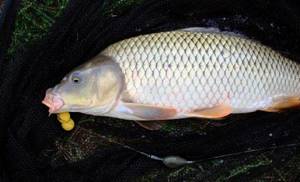
For successful fishing sessions, they look for flat bottom plateaus and carry out the initial intensive feeding of the fishing point, feeding a small diameter bait as bait. They fish with larger baits that stand out from the rest of the bait table. Depending on the activity of the fish, complementary feeding and baiting of the trophy can be carried out over several days. Given this situation, the angler must plan long-term strategies for carp trips in advance. After feeding and installing the equipment, all that remains is to wait for the bite signal, which is characterized by intensity and consistency, at which the angler should immediately hook the fish and carry out the landing.
Carp bites are sharp, ending with a self-notching trophy. Fishing is difficult, requiring pumping out fish with a reel with a properly adjusted friction brake. Fighting especially large specimens will require not only a significant amount of time, which sometimes lasts several tens of minutes, but also considerable physical effort from the fisherman.
Selection of gear
There are many ways to catch carp using boilies. Fishermen have adapted to catching this fish in different ways, which do not differ in effectiveness, but some of them are more convenient. Most likely the following gear will suit you.
Fishing with a float rod
In order for carp fishing with boilies using a float rod to be successful, you will need to acquire the following gear:
- A telescopic rod about 5 meters long.
- The rod test should be between 10 and 30 grams.
- Reel size 2500 according to Shimano classification.
- 100 meters of high-quality fishing line with a diameter of 0.25 millimeters.
- To make a leash you will need 1 meter of fishing line with a diameter of 0.2 millimeters.
- Float (load capacity is selected depending on fishing conditions).
- It is best to equip the tackle with a sliding float.
- The hook size is selected depending on the diameter of the boilie.
Feeder
Feeder gear is considered the most effective for fishing for carp and other fish. The fishing rod must be plug-in and have a very sensitive tip to detect bites.
- The rod should be about 4 meters long and with about 100 grams of dough.
- The weight of the feeder is selected in accordance with the depth at the fishing site and casting distance.
- The reel must be equipped with a baitrunner.
- The diameter of the main line is from 0.25 to 0.35 millimeters.
- The leash should be about 0.5 meters long.
getfish.net

